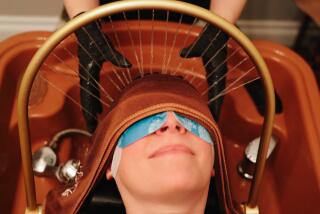Seattle Wages Tan-talizing Fight Against Winter White
- Share via
SEATTLE — When people in the Pacific Northwest start feeling blue about being winter white, they don’t get mad. They get even tans.
This winter, the worst snowstorm in a decade paralyzed Seattle, then high pressure squatting over the state produced a smelly blanket of smog and fog, but Cindy Pendergraft was gently toasting in a sunbed, thinking about everything except the weather.
“I sleep in it. I love it. It’s my escape,” Pendergraft said.
She is the well-tanned marketing director for SCA Corp., a Redmond-based tanning system distributor recently listed by Inc. magazine as the nation’s sixth-fastest-growing privately owned company.
Basking in Compliments
Twice-a-week sessions in her high-powered sunbed keep Pendergraft basking in backhanded compliments. People say, “I hate you, you have such a beautiful suntan. You make me sick, you’re so brown and gorgeous.”
“It makes me feel great,” she said.
In five years, America’s pursuit of the “I-hate-you” tan has transformed the U.S. suntan industry from a novelty to a multimillion-dollar business, with sunbed distributors and suntan salons from Portland, Ore., to Paducah, Ky., and most points between and beyond.
SCA’s sales have jumped from $120,000 in 1980 to $10 million in 1983 to $32 million last year. Projections for this year are close to $50 million.
Sales Tripled
San Francisco-based Silver Solarium boasts similar success. Tierra Cosmetics Corp. International in Redmond, Wash., which makes a tanning lotion specifically designed for use with sunbeds, has tripled its sales in a year.
The U.S. market still can’t hold a sunlamp to Europe, where tanning has been big for almost 20 years. Little Denmark alone has an estimated 30,000 sunbeds for its 5 million people. Indeed, most sunbeds distributed in the United States are imported from Europe.
U.S. tanning salons do a healthy business in places where the sun rarely shines, like Seattle; places where it always shines but people spend most of their time in cars, such as Los Angeles, and places where it shines fiercely enough to reduce sunbathers to human cinders, as in Phoenix.
Booming Business
A tanning salon operator in Alabama keeps 16 beds going 24 hours a day, seven days a week. Among other booming markets are Dallas; Sioux Falls, S.D.; Indianapolis; Atlanta and the state of New Jersey.
The Seattle area has more than 100 salons, some less than a block apart--places with names like Perfect Tan, Rapid Tan, Safe Tan, Tan-Talize, Tantropics, Tanfastic, Sunbrella, Sun Bronze, Bronze Body, Body Glo, Body Heat, the Endless Summer and the Electric Beach.
Western culture equates tanned skin with health and wealth. It’s generally assumed that tan people must spend time outside exercising and that people who are tan in January must have enough money to travel to warmer climes.
That aura of success may help explain why warnings about the skin damage, aging and disease caused by exposure to ultraviolet rays don’t seem to keep tan hounds away from sunbeds.
‘Supposed to Be Safer’
“They’ve been using them in Europe for more than 20 years, and I haven’t heard about any repercussions--’Woman’s Face Falls Off In Plaza,’ something like that,” said the receptionist at Broadway Sun Studios. “The beds are supposed to be safer than the sun, but the sun’s terrible. I guess you can rationalize anything.”
Salon operators and tanning system distributors seem to believe that controlled exposure in a sunbed is preferable to baking in natural sunlight, but dermatologists don’t buy it.
“Most people’s damage from the sun comes from cumulative exposure when they’re not even thinking about it,” said Seattle dermatologist Sanford C. Barnes, who has a mustache but no tan. “You add artificial tanning on top of that, and it just adds to your cumulative total.”
Try telling that to someone who always looks as if he just stepped off the last flight from Maui.
“With everything they say about the sun . . . we still want a tan,” said Cheri Pedee, who manages Sunbanque. “I’d rather have a few more wrinkles and feel better about myself.”
More to Read
Inside the business of entertainment
The Wide Shot brings you news, analysis and insights on everything from streaming wars to production — and what it all means for the future.
You may occasionally receive promotional content from the Los Angeles Times.










